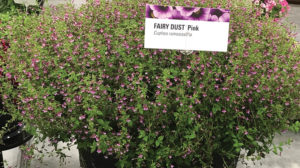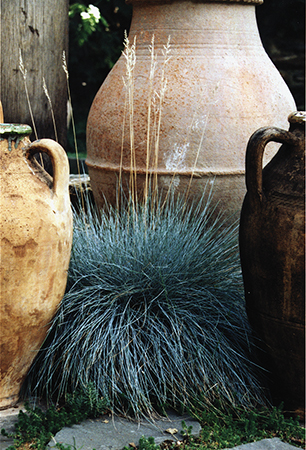Kelly Norris: Noteworthy Plants That Caught My Attention at Cultivate’17

The green inflorescences of Festuca ovina ‘Eiler’s Beauty’ (Emerald Coast Growers) mature into sprays of tan seedheads on red-tinged stalks.
I love Cultivate — the people and the programming. It’s an annual highlight in the fellowship of horticulture; an opportunity for networking, business, and education. It doesn’t have a contemporary history of being a “new plant show,” as industry parlance goes. Nevertheless, I beelined for the new varieties court, upgraded this year into a rectangular arena that democratically staged new introductions into wooden tiers with prominent signage for each entrant.
I didn’t have hours of time to study and take notes, so this was a study in impact. I often use my camera as my curatorial third arm — if I took a photo, it earned my attention. Consumers do this every day, sometimes without realizing it. The great American gardener Marco Polo Stufano approached horticulture at Wave Hill with an unwittingly futuristic fervor for the value of picture-perfect vignettes. During an interview for The New York Times, he once remarked, “We want to make pictures in our garden . . . Quite frankly, we think it’s harder to do than painting.” Instagram and a dozen other apps can make your photo look like a painting anyway.
Earned a Photo
So what was photo-worthy this year? Although I’m sure I saw them somewhere without registering it, I can’t recall a single moment from a recent trip to the United Kingdom (immediately before Cultivate) where petunias or calibrachoas abounded to great memory. That said, travel teaches toleration, and at least a few new varieties of each were grown to photo-worthy perfection. I may also have been jetlagged. The Calitastic series of calibrachoa from Westhoff Flowers was particularly dense and bold. I also took note of the color breaking ‘Crave Strawberry Star,’ an F1 calibrachoa from PanAmerican Seed. The big question for me is always how much of an impact these “breaks” have on consumers. I’ll await the verdict.
The recent success of bidens, like the Campfire series from Proven Winners and the Beedance series from Suntory Flowers, seems to have triggered an avalanche of more hot-colored, compact varieties. ‘Timeless Blazing Fire’ from Danziger was tight and loaded with blooms. Proven Winners has already improved its original offerings with ‘Campfire Fireburst Improved.’ Flowers spilled from this plant in contrast to the rangier, if not still satisfying, iteration of recent memory.
A new sunflower from Syngenta Flowers called Sunfinity takes 10 years of breeding for branching, bud count, and duration, and turns it into a 3- to 4-foot tall garden variety that would work fine in larger containers or the larger landscape. I can’t put my finger on it, but something about this charmed me. Surely there are more colors in the works. Will this appeal to consumers who want something more guaranteed, compared to a $1.99 packet of sunflower seeds at the hardware store?

Cuphea ‘Fairy Dust Pink’ (Proven Winners) offers countless options for mixed containers.
Kept Coming Back
There were a few varieties I kept coming back to and that I’ve shared with colleagues for reactions and commentary. Imagine the modern consumer getting so excited about a new plant that they shared the experience with a friend, perhaps not even a fellow gardening consumer. This is what apps like Grow It are attempting to capture — the social aspect of gardening. The new Cuphea ‘Fairy Dust Pink’ from Proven Winners is subtle, if not cerebral, but offers countless options for designers or container aficionados. Diaphanous is definitely a design trend of the moment — soft, airy, and alluring plays well with the bold colors and patterns consumers have adopted in their homes. In this realm on the gardening side of the spectrum, ‘Fairy Dust Pink’ is patently different and could be a nice alternative to anyone bored with bedding euphorbia.
Carex ‘Censation Ribbon Falls,’ from Pacific Plug and Liner, may not bowl you over with bright and showy flowers, but it strikes closer to the undercurrent of earth-consciousness in the retail marketplace. Sedges are buzzing in the design trade, and it won’t be long before consumers start to see the functional potential in this vast group of plants. The story here isn’t just color and texture and traditional stock language that nowadays almost sounds trite and robotic (I could die happy if I never heard the phrase “pop of color” again). The story is about durability, architecture, and novelty.
Also, in grasses from Emerald Coast Growers was Festuca ovina ‘Eiler’s Beauty,’ which might be my walkaway favorite from Cultivate. To think of admitting that about a rugged turf grass is nearly unfathomable, but imagine the possibilities of what you can do with a variety that spikes as well as this does. It’s made for the modern aesthetic.
Just a Pretty Face?
In general, I wish I came away more excited by the contents of the display. I’ve come to accept the contemporary status of horticultural breeding as conventional versus innovative. (Think of this in the way the prototypical sitcom mother would say “I love you no matter what you say.”)
While these varieties caught my camera and earned a few scribbles in my Evernote, all this leaves me wondering why our breeding is so incremental. Most of these introductions only scratch the mold without breaking it.
Consider this: If it’s incremental to us, imagine what it looks like to the consumer. It’s no surprise why most bedding annual varieties have such a short product lifespan. Most consumption in that single season or two is impulsive or dictated by market availability. How often do consumers really crave, desire, and want the varieties we offer them?










